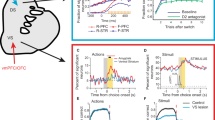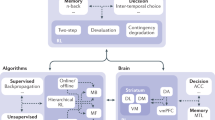Abstract
A broad range of neural and behavioral data suggests that the brain contains multiple systems for behavioral choice, including one associated with prefrontal cortex and another with dorsolateral striatum. However, such a surfeit of control raises an additional choice problem: how to arbitrate between the systems when they disagree. Here, we consider dual-action choice systems from a normative perspective, using the computational theory of reinforcement learning. We identify a key trade-off pitting computational simplicity against the flexible and statistically efficient use of experience. The trade-off is realized in a competition between the dorsolateral striatal and prefrontal systems. We suggest a Bayesian principle of arbitration between them according to uncertainty, so each controller is deployed when it should be most accurate. This provides a unifying account of a wealth of experimental evidence about the factors favoring dominance by either system.
This is a preview of subscription content, access via your institution
Access options
Subscribe to this journal
Receive 12 print issues and online access
$209.00 per year
only $17.42 per issue
Buy this article
- Purchase on Springer Link
- Instant access to full article PDF
Prices may be subject to local taxes which are calculated during checkout






Similar content being viewed by others
References
Kahneman, D. & Frederick, S. Representativeness revisited: attribute substitution in intuitive judgment. in Heuristics and Biases: the Psychology of Intuitive Judgment (eds. T. Gilovich, D.G. & Kahneman, D.) 49–81 (Cambridge University Press, New York, 2002).
Loewenstein, G. & O'Donoghue, T. Animal spirits: affective and deliberative processes in economic behavior. Working Paper 04–14, Center for Analytic Economics, Cornell University (2004).
Lieberman, M.D. Reflective and reflexive judgment processes: a social cognitive neuroscience approach. in Social Judgments: Implicit and Explicit Processes (eds. Forgas, J., Williams, K. & von Hippel, W.) 44–67 (Cambridge University Press, New York, 2003).
Killcross, S. & Blundell, P. Associative representations of emotionally significant outcomes. in Emotional Cognition: from Brain to Behaviour (eds. Moore, S. & Oaksford, M.) 35–73 (John Benjamins, Amsterdam, 2002).
Dickinson, A. & Balleine, B. The role of learning in motivation. in Stevens' Handbook of Experimental Psychology Vol. 3: Learning, Motivation and Emotion 3rd edn. (ed. Gallistel, C.R.) 497–533 (Wiley, New York, 2002).
Packard, M.G. & Knowlton, B.J. Learning and memory functions of the basal ganglia. Annu. Rev. Neurosci. 25, 563–593 (2002).
Owen, A.M. Cognitive planning in humans: neuropsychological, neuroanatomical and neuropharmacological perspectives. Prog. Neurobiol. 53, 431–450 (1997).
Yin, H.H., Ostlund, S.B., Knowlton, B.J. & Balleine, B.W. The role of the dorsomedial striatum in instrumental conditioning. Eur. J. Neurosci. 22, 513–523 (2005).
Jog, M.S., Kubota, Y., Connolly, C.I., Hillegaart, V. & Graybiel, A.M. Building neural representations of habits. Science 286, 1745–1749 (1999).
Holland, P.C. & Gallagher, M. Amygdala-frontal interactions and reward expectancy. Curr. Opin. Neurobiol. 14, 148–155 (2004).
Pasupathy, A. & Miller, E.K. Different time courses of learning-related activity in the prefrontal cortex and striatum. Nature 433, 873–876 (2005).
McClure, S.M., Laibson, D.I., Loewenstein, G. & Cohen, J.D. Separate neural systems value immediate and delayed monetary rewards. Science 306, 503–507 (2004).
O'Doherty, J. et al. Dissociable roles of ventral and dorsal striatum in instrumental conditioning. Science 304, 452–454 (2004).
Yin, H.H., Knowlton, B.J. & Balleine, B.W. Lesions of dorsolateral striatum preserve outcome expectancy but disrupt habit formation in instrumental learning. Eur. J. Neurosci. 19, 181–189 (2004).
Balleine, B.W. & Dickinson, A. Goal-directed instrumental action: contingency and incentive learning and their cortical substrates. Neuropharmacology 37, 407–419 (1998).
Coutureau, E. & Killcross, S. Inactivation of the infralimbic prefrontal cortex reinstates goal-directed responding in overtrained rats. Behav. Brain Res. 146, 167–174 (2003).
Killcross, S. & Coutureau, E. Coordination of actions and habits in the medial prefrontal cortex of rats. Cereb. Cortex 13, 400–408 (2003).
Sutton, R.S. & Barto, A.G. Reinforcement Learning: an Introduction (MIT Press, Cambridge, Massachusetts, 1998).
Houk, J.C., Adams, J.L. & Barto, A.G. A model of how the basal ganglia generate and use neural signals that predict reinforcement. in Models of Information Processing in the Basal Ganglia (eds. Houk, J.C., Davis, J.L. & Beiser, D.G.) 249–270 (MIT Press, Cambridge, Massachusetts, 1995).
Schultz, W., Dayan, P. & Montague, P.R. A neural substrate of prediction and reward. Science 275, 1593–1599 (1997).
Houk, J.C. & Wise, S.P. Distributed modular architectures linking basal ganglia, cerebellum, and cerebral cortex: their role in planning and controlling action. Cereb. Cortex 5, 95–110 (1995).
Dickinson, A. Actions and habits—the development of behavioural autonomy. Phil. Trans. R. Soc. Lond. B 308, 67–78 (1985).
Adams, C.D. Variations in the sensitivity of instrumental responding to reinforcer devaluation. Q. J. Exp. Psychol. 34B, 77–98 (1982).
Faure, A., Haberland, U., Condé, F. & Massioui, N.E. Lesion to the nigrostriatal dopamine system disrupts stimulus-response habit formation. J. Neurosci. 25, 2771–2780 (2005).
Colwill, R.M. & Rescorla, R.A. Instrumental responding remains sensitive to reinforcer devaluation after extensive training. J. Exp. Psychol. Anim. Behav. Process. 11, 520–536 (1985).
Holland, P.C. Relations between Pavlovian-instrumental transfer and reinforcer devaluation. J. Exp. Psychol. Anim. Behav. Process. 30, 104–117 (2004).
Balleine, B.W., Garner, C., Gonzalez, F. & Dickinson, A. Motivational control of heterogeneous instrumental chains. J. Exp. Psychol. Anim. Behav. Process. 21, 203–217 (1995).
Holland, P. Amount of training affects associatively-activated event representation. Neuropharmacology 37, 461–469 (1998).
Blundell, P., Hall, G. & Killcross, S. Preserved sensitivity to outcome value after lesions of the basolateral amygdala. J. Neurosci. 23, 7702–7709 (2003).
Balleine, B.W. & Dickinson, A. The effect of lesions of the insular cortex on instrumental conditioning: evidence for a role in incentive memory. J. Neurosci. 20, 8954–8964 (2000).
Izquierdo, A., Suda, R.K. & Murray, E.A. Bilateral orbital prefrontal cortex lesions in rhesus monkeys disrupt choices guided by both reward value and reward contingency. J. Neurosci. 24, 7540–7548 (2004).
Deneve, S. & Pouget, A. Bayesian multisensory integration and cross-modal spatial links. J. Physiol. (Paris) 98, 249–258 (2004).
Dearden, R., Friedman, N. & Russell, S.J. Bayesian Q-learning. in Proceedings of the 15th National Conference on Artificial Intelligence (AAAI) 761–768 (1998).
Mannor, S., Simester, D., Sun, P. & Tsitsiklis, J.N. Bias and variance in value function estimation. in Proceedings of the 21st International Conference on Machine Learning (ICML) 568–575 (2004).
Nakahara, H., Doya, K. & Hikosaka, O. Parallel cortico-basal ganglia mechanisms for acquisition and execution of visuomotor sequences - a computational approach. J. Cogn. Neurosci. 13, 626–647 (2001).
Tanaka, S.C. et al. Prediction of immediate and future rewards differentially recruits cortico-basal ganglia loops. Nat. Neurosci. 7, 887–893 (2004).
Chavarriaga, R., Strosslin, T., Sheynikhovich, D. & Gerstner, W. A computational model of parallel navigation systems in rodents. Neuroinformatics 3, 223–242 (2005).
Doya, K. What are the computations in the cerebellum, the basal ganglia, and the cerebral cortex. Neural Netw. 12, 961–974 (1999).
Suri, R.E. Anticipatory responses of dopamine neurons and cortical neurons reproduced by internal model. Exp. Brain Res. 140, 234–240 (2001).
Smith, A.J., Becker, S. & Kapur, S. A computational model of the functional role of the ventral-striatal D2 receptor in the expression of previously acquired behaviors. Neural Comput. 17, 361–395 (2005).
Dayan, P. & Balleine, B.W. Reward, motivation and reinforcement learning. Neuron 36, 285–298 (2002).
Daw, N.D., Courville, A.C. & Touretzky, D.S. Timing and partial observability in the dopamine system. in Advances in Neural Information Processing Systems 15, 99–106 (MIT Press, Cambridge, Massachusetts, 2003).
Alexander, G.E., Delong, M.R. & Strick, P.L. Parallel organization of functionally segregated circuits linking basal ganglia and cortex. Annu. Rev. Neurosci. 9, 357–381 (1986).
Baum, E.B. & Smith, W.D. A Bayesian approach to relevance in game playing. Artificial Intelligence 97, 195–242 (1997).
Pouget, A., Dayan, P. & Zemel, R.S. Inference and computation with population codes. Annu. Rev. Neurosci. 26, 381–410 (2003).
Yu, A.J. & Dayan, P. Uncertainty, neuromodulation, and attention. Neuron 46, 681–692 (2005).
Holroyd, C.B. & Coles, M.G. The neural basis of human error processing: Reinforcement learning, dopamine, and the error-related negativity. Psychol. Rev. 109, 679–709 (2002).
Botvinick, M.M., Cohen, J.D. & Carter, C.S. Conflict monitoring and anterior cingulate cortex: an update. Trends Cogn. Sci. 8, 539–546 (2004).
Hartley, T. & Burgess, N. Complementary memory systems: competition, cooperation and compensation. Trends Neurosci. 28, 169–170 (2005).
Parkinson, J.A., Roberts, A.C., Everitt, B.J. & Di Ciano, P. Acquisition of instrumental conditioned reinforcement is resistant to the devaluation of the unconditioned stimulus. Q. J. Exp. Psychol. B 58, 19–30 (2005).
Acknowledgements
We are grateful to B. Balleine, A. Courville, A. Dickinson, P. Holland, D. Joel, S. McClure and M. Sahani for discussions. The authors are supported by the Gatsby Foundation, the EU Bayesian Inspired Brain and Artefacts (BIBA) project (P.D., N.D.), a Royal Society USA Research Fellowship (N.D.) and a Dan David Fellowship (Y.N.).
Author information
Authors and Affiliations
Corresponding author
Ethics declarations
Competing interests
The authors declare no competing financial interests.
Supplementary information
Supplementary Fig. 1
Value propagation in tree search, after 50 steps of learning the task in Figure 1a. (PDF 248 kb)
Supplementary Fig. 2
Example of learning in the cache algorithm, following a single transition from state s to s′ having taken action a. (PDF 306 kb)
Rights and permissions
About this article
Cite this article
Daw, N., Niv, Y. & Dayan, P. Uncertainty-based competition between prefrontal and dorsolateral striatal systems for behavioral control. Nat Neurosci 8, 1704–1711 (2005). https://doi.org/10.1038/nn1560
Received:
Accepted:
Published:
Issue Date:
DOI: https://doi.org/10.1038/nn1560
This article is cited by
-
Disentangling the contribution of individual and social learning processes in human advice-taking behavior
npj Science of Learning (2024)
-
Learning a covert sequence of effector movements: limits to its acquisition
Psychological Research (2024)
-
Precedent as a path laid down in walking: Grounding intrinsic normativity in a history of response
Phenomenology and the Cognitive Sciences (2024)
-
A Sequential Sampling Approach to the Integration of Habits and Goals
Computational Brain & Behavior (2024)
-
Time pressure promotes habitual control over goal-directed control among individuals with overweight and obesity
Current Psychology (2024)



